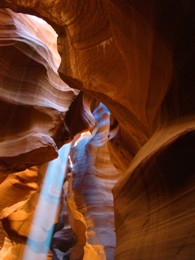Geology 166: Historical Geology 
Syllabus & Documents
What will you know when you finish this course? What new skills will you have? The following items are the Student Learning Outcomes (SLO’s) for Historical Geology. Upon successful completion of the course, you will be able to:
- Analyze the elements of the scientific method and explain how these principles apply to the study of the earth. All sciences share a common methodology of attaining knowledge that seeks to eliminate bias and prejudice in research. You will know the difference between a hypothesis and a theory (and it may very well not be what you think!).
- Use the basic geologic principles of uniformitarianism, original horizontality, lateral continuity, superposition, cross-cutting relationships, and biologic succession and the examples of present-day geologic processes to explain the formation and evolution of the features of the earth. Many people are surprised that a geologist can look at a few rocks in a roadcut or mountainside and then immediately tell a complete story of how those rocks came about. In this class, you will learn the set of principles that geologists use to tell the story of the rocks. You will have the ability to interpret the story in the rocks yourself, either in pictures and diagrams, or by visiting the localities yourself.
- Assess and evaluate competing hypotheses regarding the concept of geologic time, the origin of the earth and solar system, patterns of evolution and paleobiology, and the development and movement of continents through time. Geologists are still arguing about geological processes. This is how science is meant to work, so we will be learning how controversies and arguments are settled in geologic research.
- Test for the physical and chemical properties of minerals, and identify the most common minerals and igneous, sedimentary and metamorphic rocks. The nuts and bolts of geology is the ability to identify the most common rocks and minerals. You will know fully 95% of all the minerals and rocks anyone will ever ask you about! We will especially observe sedimentary rocks and the structures they have that reveal the past history of the earth and its environment.
- Interpret geologic features and landforms from geologic and paleogeographic maps. Historical geologists reconstruct past worlds through the use of these maps; we will do the same, figuring out the locations of ancient mountain ranges, valleys and oceans, where none exist today
- Identify and interpret the evolution of life through time through the observation and analysis of fossil specimens. The record of life is replete with strange creatures of great diversity. We will learn of the extensive fossil record that exists in the rocks.
- Explain the necessary role of the historical geologist in the modern technological society in areas such as urban planning, the search for new energy resources, and environmental research. Can we drill offshore of California and bring back $2/gallon gas? Are politicians correct when they say global warming is not real, or that what we are now experiencing is a natural, repeating process? What are the long-term effects of human activity on the biosphere? Are we causing a mass extinction event like those of the geologic past? (yes) Geologists have a lot to say about these issues, and you will understand how scientists approach these problems.

